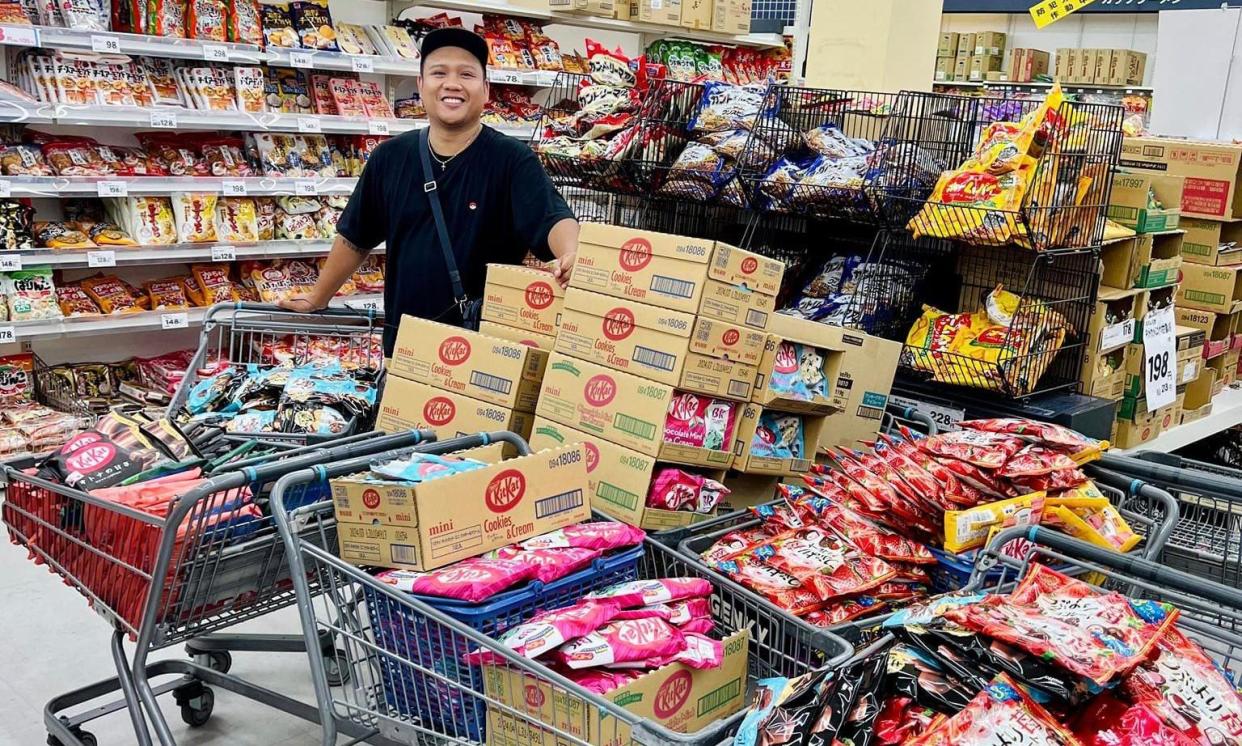South-east Asia’s quirky, sweary shopping stars cashing in on livestream selling

There are times when other customers browsing the malls in Gifu city, Japan, seem to wonder why Kenneth Gongon Watanabe is buying so many items, and why he is talking so energetically on his phone.
But the goods in his trolleys – which can range from hoards of shoes and anime socks, to stacks of Japanese sweets and matcha latte powders – are not for him. They’re actually being bought by dozens of customers in Watanabe’s home country, the Philippines, who follow live on Facebook as he browses the shops.
His live broadcasts can last for a couple of hours or more, and involve him wandering the aisles demonstrating products, and hunting for brands requested by viewers. “When viewers see lives that are not energetic or fun to watch, they tune out,” he said. “I really drink energy drinks before selling.” He picks out Japanese chocolates, shares advice with viewers on which coffee brands are best, and even what type of tea is effective for acid reflux.
Live selling – where sellers promote goods live on social media and ship items directly to customers – has grown rapidly in the Philippines since Covid, when lockdown restrictions prompted small businesses to search for new ways to reach customers. Since then, platforms such as TikTok have adapted their services to make it easier to buy and sell products online, further boosting the sector.
While Watanabe’s online shop is one of several that offers customers a chance to buy products from abroad, many others are local shops based in the Philippines. Similar businesses have grown in number in other south-east Asian countries.
It was unsurprising that live selling, which first boomed in China, had spread in popularity in the region, given its longstanding links with trade and commerce in China, said Jianggan Li, chief executive of Momentum Works, a tech research firm based in Singapore.
The market was dominated by smaller merchants, he said, adding they were not hampered by the same kinds of brand guidelines that could restrain large companies. “They’re much more agile, and they’re not afraid of mistakes,” he said. “They tend to evolve pretty fast, and they tend to be quite competitive.”
Having a quirky style can also help live sellers reach a wider audience. In Singapore during Covid, Wang Lei, a singer, found unlikely fame selling fish online, due to his expletive-laden sales talk.
In the Philippines too, sellers put on lively performances, and some viewers tune in simply for entertainment. Watanabe said he is happy viewers are watching, even if they don’t make a purchase – and he will give shout outs to regular viewers.
For Watanabe, an average session on Facebook live usually draws between 50 and 100 viewers, with his most popular being watched by about 300 people. The profit ranges from 10,000-20,000 pesos (£140-£280) per two- to four-hour session – but if there’s a sale in the mall, this can total 60,000 pesos.
Emerald A Soledad, of Jose Rizal Memorial State University, who has researched online selling, said the main advantage for sellers was convenience and lower costs. “You only need a tripod, your phone and then the ring light,” she said. There is no need for a physical store, and it is possible to reach a far wider range of customers. For mothers who were caring for children at home, it was an opportunity to earn extra income, she added.
Products sold range from snacks and household items to luxury goods. Vee Javier began selling perfumes through Facebook live in May 2022. “I started with five viewers, eight viewers,” she said, but interest grew. It was when she began to receive orders from distant areas of the country that she realised the business was becoming a success. Her shop now has 44,000 followers, and she broadcasts for three to four hours a day – or longer during busy periods.
She focused on sharing her subject knowledge with clients, she said, trying out perfumes, explaining a scent’s character, and asking viewers questions. “Perfumes depend on a lot of things – age, location and body chemistry, and personal preference of the client,” she said. She can sell up to 300 bottles in a normal broadcast – or twice as much if there is a sale.
There are challenges associated with live selling, beyond the obvious difficulties of judging shoe sizes, or the scent of a perfume, when ordering from home. Scammers have been known to set up fake accounts imitating legitimate sellers. Some shoppers have complained of merchants who sell poor-quality goods, and sellers face the problem of customers who place orders but later fail to provide payment.
There is also uncertainty associated with regulation of social media platforms, and the question of how booming online sales can affect traditional, offline markets.
In September, Indonesia banned online selling on social media apps, accusing them of predatory pricing that was damaging small businesses. It forced the closure of TikTok Shop, owned by China’s ByteDance – a major blow for the app, which is already facing intense scrutiny in other countries, including the US, over concerns about user data. Earlier this month, TikTok announced a $1.5bn investment with GoTo, owner of the popular local online shopping platform Tokopedia, which will allow it to restart its online shop in Indonesia.
In the Philippines the government is also investigating whether to ban security officials from using the app, though the president, Ferdinand Marcos Jr, has said that he wants TikTok Shop to help small merchants, especially those in rural areas, to promote their goods.
For Watanabe, live selling is definitely the future of shopping.
“The customers get the items without having to go to different malls. They save their time finding items,” he said, adding he wanted to give the same attention to customers that people might receive in a luxury store. “I want them to feel they are special.”


